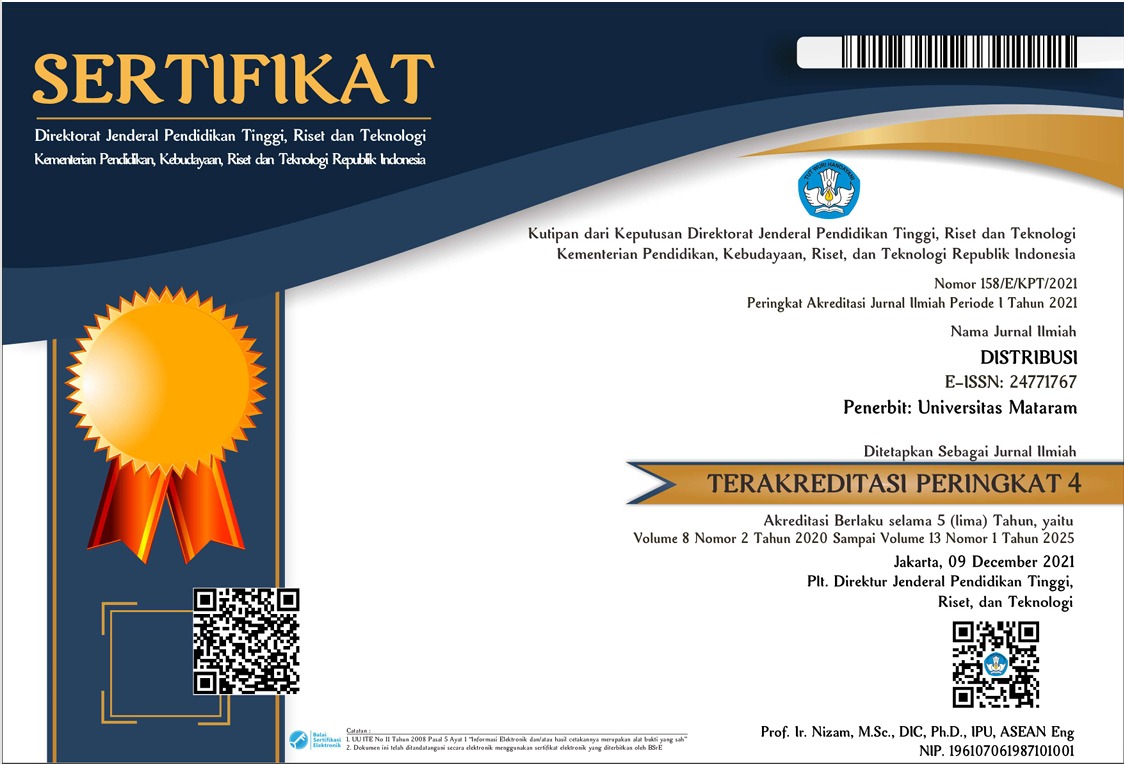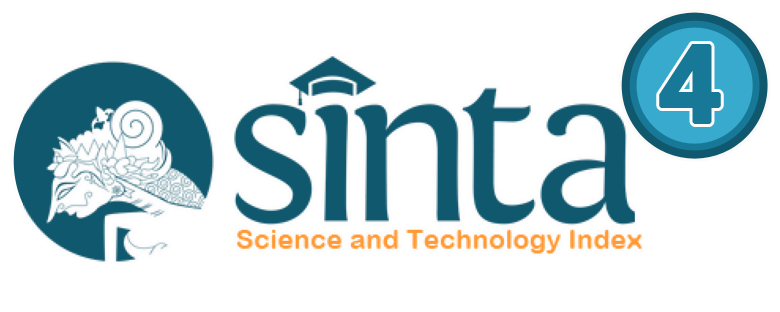THE INFLUENCE OF DATA-DRIVEN MARKETING ON PURCHASING DECISIONS AND CUSTOMER LOYALTY STUDIES AT BRAVO SUPERMARKET BOJONEGORO
DOI:
https://doi.org/10.29303/distribusi.v13i2.650Kata Kunci:
Customer Loyalty, Data-Driven Marketing, Purchase Decision, Retail MarketingAbstrak
This study investigates the impact of data-driven marketing on purchasing decisions and customer loyalty, focusing on a local retail context rarely explored in previous literature. Specifically, the research examines how the use of personalized marketing strategies based on customer data influences consumer behavior at Bravo Supermarket in Bojonegoro, Indonesia. Employing a quantitative approach with a cross-sectional survey design, the study collected data from a randomly selected sample of 100 customers using a structured questionnaire. The instrument measured customer perceptions of data-driven marketing strategies—such as personalized offers, targeted discounts, and purchase-based recommendations—as well as levels of satisfaction and loyalty. Empirical findings reveal a significant positive relationship between data-driven marketing and both purchasing decisions and customer loyalty. Customers responded favorably to marketing efforts tailored to their individual preferences and buying history, indicating that personalization enhances shopping experiences and encourages repeat purchases. Furthermore, loyalty programs like membership cards and reward systems, which are supported by customer data, were found to effectively strengthen long-term customer engagement. The results imply that even in regional retail settings, leveraging customer data can be a powerful tool for enhancing marketing effectiveness and building emotional connections with customers. This study contributes to the literature by providing localized insights into the practical benefits of data-driven marketing strategies in emerging markets.
Unduhan
Referensi
A. Muri Yusuf, M.Pd. (2014). Metode Penelitian Kuantitatif, Kualitatif & Penelitian Gabungan. Jakarta: PT Fajar Interpratama Mandiri.
Ajay Kumar, Ravi Shankar, dan Naif Radi Aljohani (2019). A Big Data-Driven Framework for Demand-Driven Forecasting Incorporating Promotional Marketing Activities. Industrial marketing Management. 90. 493-507.
Alalwan, A. A. (2020). Mobile food ordering apps: An empirical study of the factors affecting customer e-satisfaction and continued intention to reuse. International Journal of Information Management, 50, 28-44. https://doi.org/10.1016/j.ijinfomgt.2019.04.008
Blasius Erik Sibarani (2024). Penggunaan Data Analistik dalam Strategi Pemasaran untuk Mempertahankan Loyalitas Pelanggan. Jurnal MENTARI: Manajemen, Pendidikan dan Teknologi Informasi. 3(1). 30-39
Chen, Y., & Wang, R. (2022). Data-driven marketing and customer loyalty: The mediating role of personalized experiences. Journal of Retailing and Consumer Services, 64, 102803. https://doi.org/10.1016/j.jretconser.2021.102803
Davenport, T. H., & Dyché, J. (2013). Big data in big companies. Harvard Business Review Analytic Services.
Dessyana Juwita Cindy. (2013). Store Atmosphere Pengaruhnya Terhadap Keputusan Pembelian Konsumen Di Texas Chicken Multimart II Manado. Jurnal EMBA 845 Vol.1, No.3.
Dwivedi, Y. K., Ismagilova, E., Hughes, D. L., Carlson, J., & Rafferty, L. (2021). Artificial intelligence for decision making in the era of Big Data – Evolution, challenges, and research agenda. International Journal of Information Management, 60, 102398. https://doi.org/10.1016/j.ijinfomgt.2021.102398
Ghozali, I. (2016). Aplikasi Analsis Multivariete Dengan Program IBM SPSS 23. Semarang: Badan Penerbit Universitas Diponegoro.
Kotler, P., & Keller, K. L. (2016). Marketing Management (15th ed.). New Jersey: Pearson Education.
Lamb, C. W., Hair, J. F., & McDaniel, C. (2019). MKTG 12: Principles of Marketing (12th ed.). Cengage Learning.
Leeflang, P. S., Verhoef, P. C., Dahlström, P., & Freundt, T. (2014). Challenges and solutions for marketing in a digital era. International Journal of Research in Marketing, 31(1), 1-12.
Lemon, K. N., & Verhoef, P. C. (2016). Understanding customer experience throughout the customer journey. Journal of Marketing, 80(6), 69-96. https://doi.org/10.1509/jm.15.0420
Liu, Y., Li, H., & Hu, F. (2013). Website attributes in urging online impulse purchase: An empirical investigation on consumer perceptions. Decision Support Systems, 55(3), 829-837. https://doi.org/10.1016/j.dss.2013.04.001
Martin, K. D., & Murphy, P. E. (2017). The role of data privacy in marketing. Journal of Marketing Research, 54(2), 240-255.
Vaynerchuk, G. (2021). "Crushing It!: How Great Entrepreneurs Build Their Business and Influence and How You Can, Too." HarperCollins
Verhoef, P. C., Lemon, K. N., Parasuraman, A., Roggeveen, A., Tsiros, M., & Schlesinger, L. A. (2010). Customer Experience Creation: Determinants, Dynamics, and Management Strategies. Journal of Retailing, 85(1), 31-41
Rust, R. T., & Huang, M. H. (2014). The Service Revolution and the Transformation of Marketing Science. Marketing Science, 33(2), 206-221
Schiffman dan Kanuk. (2019). Perilaku konsumen. Edisi tujuh. Jakarta: Penerbit Indeks.
Setiadi Nugroho (2010). Perilaku Konsumen: Konsep dan Implikasi Untuk Strategi dan Penelitian Pemasaran. Jakarta: Kencana.
Sugiyono (2017). Metode Penelitian Kuantitatif Kualitatif dan R&D. Bandung: Alfabeta
Sutiningsih (2021). Peran Loyalitas Pelanggan Pada Marketing Mix Terhadap Keputusan Konsumen.12(2). 50-59
Wedel, M., & Kannan, P. K. (2016). Marketing Analytics for Data-Rich Environments. Journal of Marketing, 80(6), 97-121
Wicaksono, A., & Maryani, I. (2018). Analisis Persebaran, Pola, dan Pertumbuhan Ritel Modern di Kabupaten Bojonegoro. Jurnal Ilmiah Geomatika, 24(2), 141-148
Zhang, M., Guo, L., & Hu, M. (2024). How data analytics capabilities shape customer loyalty in the retail sector: Evidence from emerging markets. Journal of Consumer Behaviour, 23(1), 45-61. https://doi.org/10.1002/cb.2215
##submission.downloads##
Diterbitkan
Cara Mengutip
Terbitan
Bagian
Lisensi
Hak Cipta (c) 2025 Fauzian Noor, M. Rizky Agustino, Agesti Martha Juwita

Artikel ini berlisensiCreative Commons Attribution-ShareAlike 4.0 International License.
Penulis yang mengirimkan naskah harus memahami dan menyetujui bahwa jika diterima untuk dipublikasikan, hak cipta dari artikel adalah milik Distribusi. Hak cipta (copyright) meliputi hak eksklusif untuk mereproduksi dan memberikan artikel dalam semua bentuk dan media, termasuk cetak ulang, foto, mikrofilm dan setiap reproduksi lain yang sejenis, serta terjemahan. Distribusi, Fakultas Ekonomi dan Bisnis Universitas Mataram, dan Editor melakukan segala upaya untuk memastikan bahwa tidak ada data, pendapat atau pernyataan yang salah atau menyesatkan yang dipublikasikan di jurnal ini. Isi artikel yang diterbitkan di Distribusi adalah tanggung jawab tunggal dan eksklusif dari masing-masing penulis.








